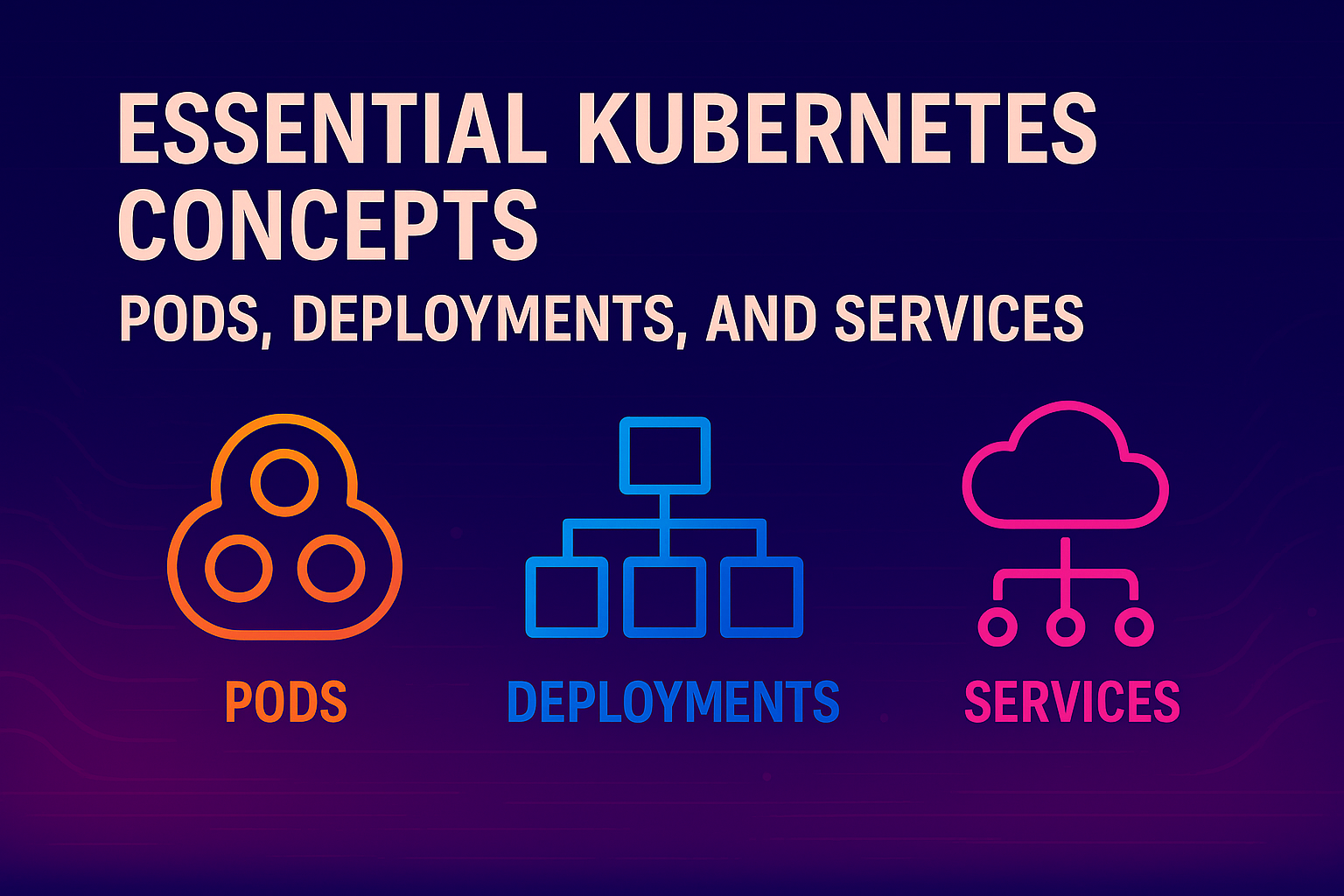Part 4 - Essential Kubernetes Concepts: Pods, Deployments, and Services
Pods, Deployments, and Services are the holy trinity of Kubernetes—master them, or prepare for divine debugging interventions.”

Picture this: You've containerized your application, set up a Kubernetes cluster, and now you're staring at the terminal wondering, "What exactly am I supposed to do next?" Don't worry—you're about to meet the three musketeers of Kubernetes that will transform your containerized application into a resilient, scalable masterpiece. Let's dive into the world of pods, deployments, and services with a touch of humor and plenty of practical insights.
Pods: The Cozy Homes Where Containers Live
If containers are the hermetically sealed packages containing your application code, then pods are the studio apartments where these containers take up residence. A pod is the smallest deployable unit in Kubernetes—the atomic building block upon which everything else is built.
Why Pods and Not Just Containers?
Imagine trying to move your entire bedroom set—bed, nightstands, lamps, and all related items—to a new house. You wouldn't transport each item separately across town; you'd move them together because they function as a unit. That's exactly what pods do for containers.
Pods encapsulate one or more tightly coupled containers that:
- Share the same network namespace (they can talk to each other via localhost)
- Share the same storage volumes
- Share the same lifecycle (they're created and destroyed together)
This shared context allows for some powerful patterns. For instance, research on "Live Migration of Multi-Container Kubernetes Pods in Multi-Cluster Serverless Edge Systems" demonstrates how these pod-level abstractions enable advanced functionality like migrating entire application components between clusters without modification to Kubernetes' standard API.
The Pod Lifecycle: Born to Die
Here's something that trips up many Kubernetes newcomers: pods are ephemeral. They're designed to die and be replaced, like worker bees in a hive. When a node fails or resources run low, Kubernetes might simply terminate your pods and reschedule them elsewhere.
apiVersion: v1
kind: Pod
metadata:
name: my-standalone-pod
labels:
app: web-frontend
spec:
containers:
- name: web-app
image: nginx:1.19
ports:
- containerPort: 80
This YAML defines a simple pod, but here's the catch—if this pod dies, nothing will recreate it. That's why we rarely create naked pods in production. Instead, we wrap them in something more resilient: deployments.
Deployments: Your Application's Guardian Angels
If pods are the individual soldiers, deployments are the generals that manage the entire army. They ensure that the specified number of pod replicas are running at all times, regardless of node failures or other calamities.
What Makes Deployments Magical?
Deployments provide several superpowers:
- Self-healing: If a pod goes down, the deployment creates a new one
- Scaling: Need more capacity? Just change the replica count
- Rolling updates: Deploy new versions without downtime
- Rollbacks: "Oops, that didn't work!" No problem, just roll back to the previous version
Research into "Efficient Resource Management of Kubernetes Pods using Artificial Intelligence" highlights how modern systems are even applying AI to optimize deployment resource allocation, making them even more powerful.
Here's a deployment in action:
apiVersion: apps/v1
kind: Deployment
metadata:
name: web-frontend
spec:
replicas: 3
selector:
matchLabels:
app: web-frontend
template:
metadata:
labels:
app: web-frontend
spec:
containers:
- name: web-app
image: nginx:1.19
ports:
- containerPort: 80
With this configuration, Kubernetes will maintain exactly three replica pods running our web application. If a node crashes or a pod fails its health check, the deployment controller springs into action, spinning up replacement pods to maintain the desired state.
Rolling Updates: The Secret Sauce
One of the most delightful aspects of deployments is their ability to perform rolling updates. Let's say you've identified a bug in your application and need to deploy a fix:
kubectl set image deployment/web-frontend web-app=nginx:1.20
This simple command triggers a sophisticated dance:
- Kubernetes creates a new pod with the updated image
- Once the new pod is healthy, an old pod is terminated
- This process repeats until all pods are running the new version
The best part? Your users never notice a thing. No downtime, no interruption—just a seamless transition to the new version.
Studies on "Adaptive scaling of Kubernetes pods" have shown that these deployment mechanisms are critical for efficient resource utilization in modern cloud environments.
Services: The Networking Magicians
So we have pods being managed by deployments, but there's still a critical piece missing: how do other components find and communicate with these pods?
This is where services enter the stage. Think of services as the maitre d' of a fine restaurant—they direct traffic to the right tables (pods), even as those tables change locations or get replaced.
Why Services Are Essential
Remember how pods are ephemeral? Each time a pod is recreated, it gets:
- A new identity
- A new IP address
- A fresh start in life
This is problematic if other components need to communicate with that pod. Services solve this by providing a stable endpoint that remains consistent regardless of what happens to the underlying pods.
Types of Services for Different Needs
Kubernetes offers several flavors of services:
- ClusterIP: The default type, accessible only within the cluster
- NodePort: Exposes the service on a static port on each node
- LoadBalancer: Provisions an external load balancer that routes to the service
- ExternalName: Maps the service to a DNS name
Here's a simple service definition:
apiVersion: v1
kind: Service
metadata:
name: web-frontend-service
spec:
selector:
app: web-frontend
ports:
- port: 80
targetPort: 80
type: LoadBalancer
The magic happens in the selector field—it matches the labels of our deployment's pods, automatically routing traffic to all matching pods. If a pod dies and the deployment creates a replacement, the service automatically updates its routing table.
Recent research on "SAGE — A Tool for Optimal Deployments in Kubernetes Clusters" demonstrates how proper service configuration significantly impacts application performance and resource utilization.
The Story of MicroGrocer: Putting It All Together
Let me tell you about my friend Sarah, a DevOps engineer for an online grocery startup called MicroGrocer. She was tasked with deploying their three-tier application to Kubernetes.
"It's like building with LEGO," she told me over coffee. "Each piece has its purpose, but the magic happens when you connect them properly."
Sarah's application had three main components:
- Web Frontend: Customer-facing website
- Order Service: Processes incoming orders
- Inventory Database: Tracks product availability
Sarah's Kubernetes Symphony
First, Sarah created three deployments:
# Frontend deployment with 3 replicas
apiVersion: apps/v1
kind: Deployment
metadata:
name: web-frontend
spec:
replicas: 3
# ... rest of deployment spec ...
# Order service deployment with 2 replicas
apiVersion: apps/v1
kind: Deployment
metadata:
name: order-service
spec:
replicas: 2
# ... rest of deployment spec ...
# Database deployment with 1 replica
apiVersion: apps/v1
kind: Deployment
metadata:
name: inventory-db
spec:
replicas: 1
# ... rest of deployment spec ...
Then, she connected them with services:
# Frontend service exposed to the internet
apiVersion: v1
kind: Service
metadata:
name: web-frontend-service
spec:
type: LoadBalancer
# ... rest of service spec ...
# Internal order service
apiVersion: v1
kind: Service
metadata:
name: order-service
spec:
type: ClusterIP
# ... rest of service spec ...
# Internal database service
apiVersion: v1
kind: Service
metadata:
name: inventory-db
spec:
type: ClusterIP
# ... rest of service spec ...
With this architecture:
- The web frontend could scale to handle traffic spikes
- The order service could process orders reliably
- The database maintained state
- All components could find each other through services
One day, disaster struck. The node running one of the frontend pods crashed. Sarah received an alert on her phone but before she could even respond, she saw Kubernetes had already:
- Detected the pod failure
- Scheduled a new pod on another node
- Updated the service routing table
- Resumed normal operation
"It's like having a self-healing application," she grinned. "The deployments maintain the right number of pods, and the services ensure they can always find each other. I just declare what I want, and Kubernetes makes it happen."
Beyond the Basics: Advanced Pod Patterns
As Sarah's team got more comfortable with Kubernetes, they started implementing more sophisticated patterns:
Multi-Container Pods
For logging, they added sidecar containers to their pods:
spec:
containers:
- name: web-app
image: microgrocer/frontend:v2
- name: log-collector
image: fluentd:v1.12
# Collects logs from the main container
Research on multi-container pods shows they're especially valuable in edge computing scenarios, where coordinated container groups need to be migrated between clusters.
Autoscaling Pods
To handle variable traffic, they implemented Horizontal Pod Autoscaler:
apiVersion: autoscaling/v2
kind: HorizontalPodAutoscaler
metadata:
name: web-frontend-hpa
spec:
scaleTargetRef:
apiVersion: apps/v1
kind: Deployment
name: web-frontend
minReplicas: 3
maxReplicas: 10
metrics:
- type: Resource
resource:
name: cpu
target:
type: Utilization
averageUtilization: 70
Recent studies on "Security-Enhanced QoS-Aware Autoscaling of Kubernetes Pods" highlight how these mechanisms maintain performance while ensuring security requirements are met.
The Kubernetes Dance: Choreographing Containers at Scale
What Sarah realized—and what you should take away from this blog—is that Kubernetes is essentially a choreographer. Pods, deployments, and services work together in a beautiful dance:
- Pods provide the environment where containers run
- Deployments ensure pods are always running in the right numbers
- Services ensure they can find and talk to each other
This choreography enables applications to achieve levels of resilience, scalability, and maintainability that were once the exclusive domain of tech giants.
Where Do We Go From Here?
Now that you understand the core building blocks of Kubernetes applications, you're ready to start deploying your own. In the next post, we'll explore how to manage application configuration with ConfigMaps and Secrets—because even the most well-architected application needs its settings and secrets managed properly.
Remember, every Kubernetes master started as a confused beginner staring at YAML files. The difference is they kept experimenting, kept learning, and kept dancing with these core concepts until the choreography became second nature.
So fire up your terminal, create your first deployment, and join the dance. Your containers are waiting to be orchestrated!

